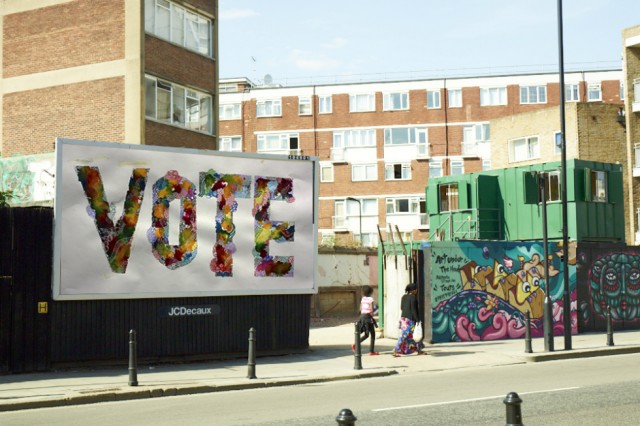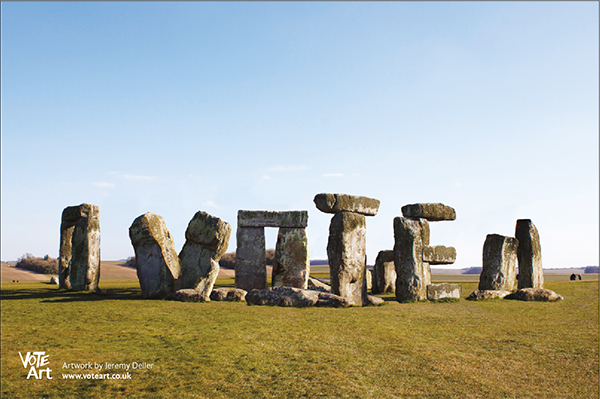Vote Art?
Or preaching to the converted? In a personal take on the looming General Election, Laura Harris voices her concerns about the relationship between contemporary art and parliamentary politics…
Occupying a space usually reserved for imperatives like ‘ENJOY COKE’ or ‘COMPARE THE MARKET’, Fatima Bergum’s ‘VOTE’ looms over Leece Street in Liverpool at the moment; big, bright, bold lettering bearing down on passers-by.
Bergum’s work forms part of the Vote Art project, a series of commissions on streets just like this one across the country, from artists including Jeremy Deller and Bob and Roberta Smith. The latter, whose real name is Patrick Brill, is widely known for his art party conferences, and is now standing against Tory MP Michael Gove in Surrey Heath at the general election. The Vote Art project dogmatically demands those catching a glimpse of one of its special billboards to enact their democratic right on May 7th. Postcards of the works are also available in national galleries (including at FACT Liverpool), canvassing cultural consumers.
But is this powerful word art? Is it even good art? I believe that the Vote Art project demonstrates worrying tendencies in both contemporary art and parliamentary politics.
By mimicking advertising, and unquestionably advocating the electoral system, Vote Art is indicative of a wilful lack of criticality within mainstream contemporary art. Structures of power and capital actively support the contemporary art ‘market’, built as it is on foundations of obscene private capital (see a recent Guardian article on Sotheby’s highest ever art auction sales). Similarly, powerful political parties rely on the current electoral voting system to retain power disproportionate to the votes received (see First Past the Post (FPTP), also known as Single Member Pluality, Simple Majority Voting or Plurality Voting).
By presenting ‘voting’ and ‘art’ together, the Vote Art project signifies, therefore, the intentional failure of both contemporary art and politics to encourage — or even entertain — alternatives.

The rhetoric of advertising and Vote Art functions by presenting imperatives without the need of justification or a dialogue. This is the antithesis of a well-functioning democracy founded on discussion and debate. What’s more, by using the space and language of advertising, viewers of Vote Art are forced into the role of passive consumer. Again, this is antithetical to democracy. A truly democratically minded project should attempt to free the viewer from the isolating impacts of consumer culture (the ‘buy this limited edition print so no one else can have it’ mentality) in order to cast a considerate ‘VOTE’.
Beyond rhetorical devices, it is also important to assess what following the Vote Art commandment actually means. To draw parallels with the theorisation of participatory art, the electoral system in the UK — occurring once every five years and using the first-past-the-post system — is at best very limited participation, and at worse purely symbolic. The participant is free only to act within limited and exteriorly predetermined categories (i.e. parties, candidates). Even the physicality of the act is fixed; mark an ‘X’, or your ballot is spoilt. Authorial control over this participation is as total as possible.

Participatory art projects are often motivated by a desire to empower the participants, enabling them to enact change in their social situation. If a vote on May 7th was truly participatory, therefore, the resultant parliament would be representative of the needs of the people that voted for it. Instead, the number of ethnic minority MPs needs to increase by 433% to become representative of the British population, and women MPs make up only a shocking 22.7% of parliament as a whole.
Even the realisation of the project is ideologically conservative. By circulating the postcards at galleries, places which (unfortunately) attract ‘the wealthiest… and least ethnically diverse 8% of the population’ (Warwick Commission, p. 33), the project is limited to encouraging voices once again unrepresentative of society. This shows the flaccidity of Vote Art, as the section of society it reaches is likely to vote anyway, even without an arty typeface; in the last election there was a 70% turnout from the upper-classes, against a working class turnout of 54% (see the 2005 election class statistics). The balance does not need to be tipped any further in favour of the privileged.
The Vote Art project is at best a misjudged and poorly thought-out avocation of democracy, and at worst a dangerous curtailment of dialogue borne of ideological conservatism. It demonstrates a failure of contemporary art and parliamentary politics to encourage meaningful change to societal systems.
Contrary to the premise of Vote Art, democracy and art should both strive towards being spaces for active participation. Both have the potential to create a fairer and more enjoyable world to live in. Politics, like art, should be something you do, not something that is done to you.
Laura Harris
See the Vote Art exhibition at Peckham Platform, London, 11am-6pm, until its last day on Thursday 7 May 2015 — free entry
Vote Art is an arts initiative inspired by the theme of democracy that aims to encourage people to take part in the democratic process; see more at voteart.co.uk
Read our Big Interview with Bob and Roberta Smith
Read My Day As An Art Party Pilot
Read the Arts Council’s Summary of party manifestos: what they mean for arts, culture and creativity





